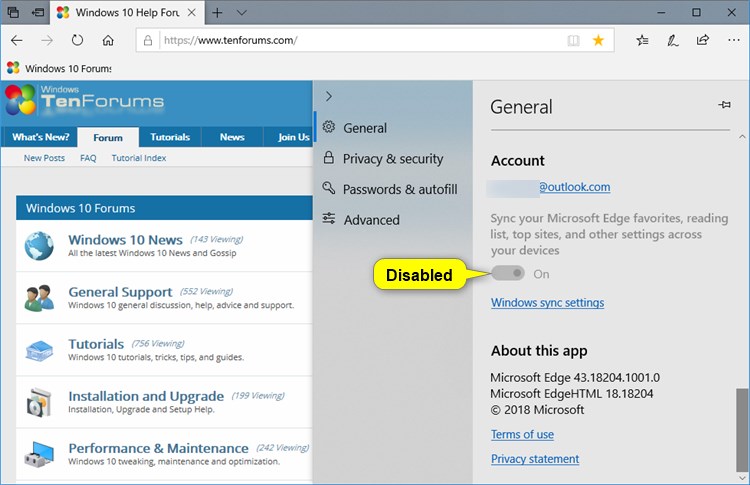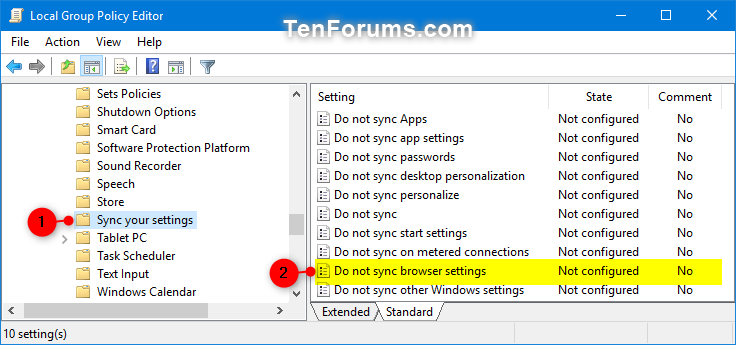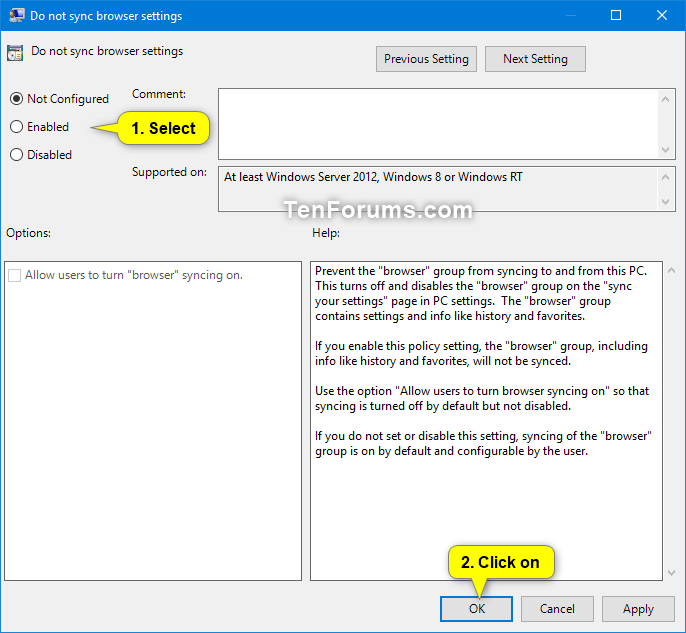How to Enable or Disable Sync Microsoft Edge Settings in Windows 10
Microsoft Edge is a new web browser that is available across the Windows 10 device family. It is designed for Windows 10 to be faster, safer, and compatible with the modern Web.
The “browser” group syncs automatically between user’s devices and allowing users to choose to make changes. The “browser” group uses the Sync your Settings option in Settings to sync Microsoft Edge settings, such as favorites, reading list, top sites, and other settings.
By default, users can turn on or off to sync their Microsoft Edge settings across Windows 10 devices they sign in with the same Microsoft account.
Starting with Windows 10 build 17713 (announced in Windows 10 build 17723), you can use a new Do not sync browser settings group policy to enable or disable users from being able to sync their Microsoft Edge settings on the PC.
This tutorial will show you how to enable or disable syncing Microsoft Edge settings for all users in Windows 10.
You must be signed in as an administrator to enable or disable syncing Microsoft Edge settings.
- Option One: Enable or Disable Sync Microsoft Edge Settings in Local Group Policy Editor
- Option Two: Enable or Disable Sync Microsoft Edge Settings using a REG file
EXAMPLE: Sync Microsoft Edge settings disabled
The Local Group Policy Editor is only available in the Windows 10 Pro, Enterprise, and Education editions.
All editions can use Option TWO below.
1. Open the Local Group Policy Editor.
2. In the left pane of Local Group Policy Editor, navigate to the location below. (see screenshot below)
Computer Configuration\Administrative Templates\Windows Components\Sync your settings
3. In the right pane of Sync your settings in Local Group Policy Editor, double click/tap on the Do not sync browser settings policy to edit it. (see screenshot above)
4. Do step 5 (enable) or step 6 (disable) below for what you want.
A) Select (dot) Not Configured or Disabled, click/tap on OK, and go to step 7 below. (see screenshot below)
Not Configured is the default setting.
A) Select (dot) Enabled, click/tap on OK, and go to step 7 below. (see screenshot below)
If you want syncing turned off by default but not disabled, select the Allow users to turn “browser” syncing on option.
7. You can close the Local Group Policy Editor if you like.
8. If Microsoft Edge is currently open, then close and reopen the browser to apply.
The downloadable .reg files below will add and modify the DWORD values in the registry key below.
HKEY_LOCAL_MACHINE\SOFTWARE\Policies\Microsoft\Windows\SettingSync
DisableWebBrowserSettingSync DWORD
delete = Enable
2 = Disable
DisableWebBrowserSettingSyncUserOverride DWORD
delete = Enable
1 = Disable
1. Do step 2 (enable) or step 3 (disable) below for what you want.
This is the default setting.
A) Click/tap on the Download button below to download the file below, and go to step 4 below.
Enable_sync_Microsoft_Edge_settings.reg
Download
A) Click/tap on the Download button below to download the file below, and go to step 4 below.
Disable_sync_Microsoft_Edge_settings.reg
Download
4. Save the .reg file to your desktop.
5. Double click/tap on the downloaded .reg file to merge it.
6. When prompted, click/tap on Run, Yes (UAC), Yes, and OK to approve the merge.
7. If Microsoft Edge is currently open, then close and reopen the browser to apply.
8. If you like, you can now delete the downloaded .reg file.
That's it,
Shawn
Related Tutorials
- How to Turn On or Off Sync Microsoft Edge Settings across Windows 10 Devices
- How to Turn On or Off Sync Your Settings in Windows 10
- How to Enable or Disable Sync Your Settings in Windows 10
- How to Enable or Disable Sync Your Settings on Metered Connections in Windows 10
- How to Backup and Restore Microsoft Edge Favorites in Windows 10
- How to Enable or Disable Syncing Passwords in Sync Your Settings on a Windows 10 PC
- How to Enable or Disable Syncing Theme in Sync Your Settings on a Windows 10 PC
- How to Enable or Disable Syncing Other Windows Settings in Sync Your Settings on a Windows 10 PC
Enable or Disable Sync Microsoft Edge Settings in Windows 10

Enable or Disable Sync Microsoft Edge Settings in Windows 10
How to Enable or Disable Sync Microsoft Edge Settings in Windows 10Published by Shawn BrinkCategory: Browsers & Email
21 May 2021
Tutorial Categories


Related Discussions





